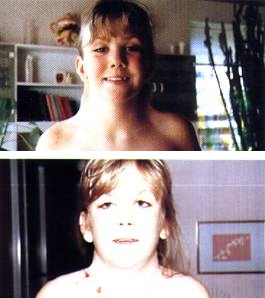特纳氏综合征
此条目可参照英语维基百科相应条目来扩充。 (2018年9月21日) |
透纳氏症(英语:Turner syndrome,缩写:TS),或称 45,X / 45,X0(代表X染色体表达数);为基因疾患中性腺发育不良的一种,是雌性个体因X染色体部分或完全缺失而引发的疾病[1]。透纳氏症患者的症状各异,患者常常会有短而成蹼状的颈部、低耳位、颈后发际线较低、矮小,出生时即手脚水肿等特征。一般来说,透纳氏症患者因其性功能无法正常发育,会导致没有月经、乳房不发育以及不孕,且会患有先天性心脏病、糖尿病以及甲状腺功能低下症的机率较正常人高。大部分的透纳氏症患者的智力水准正常,但许多患者的空间视觉能力低下,比如学习数学所需要的空间视觉能力[2]。透纳氏症患者有视觉和听觉障碍的机率也较正常人高[3]。
| 特纳氏综合征 | |
|---|---|
 | |
| 经过颈部织带手术前后的特纳氏综合症女孩 | |
| 类型 | 性腺发育不良[*]、X chromosome number anomaly with female phenotype[*]、疾病 |
| 分类和外部资源 | |
| 医学专科 | 小儿科、医学遗传学 |
| ICD-11 | LD50.0 |
| ICD-10 | Q96 |
| DiseasesDB | 13461 |
| MedlinePlus | 000379 |
| eMedicine | 949681 |
| Orphanet | 881 |
病因与诊断
编辑透纳氏症并不是一种会遗传自父母亲的疾病[4]。目前所知没有任何环境因素会导致此病症,同时也和妈妈的怀孕年龄没有关系[4][5]。透纳氏症主要肇因于染色体异常,为X染色体部份或整条有缺失或改变而致。大部分人拥有46条染色体,但患有透纳氏症的患者却仅有45条[6]。在某些情况下,染色体的异常现象只出现在部分细胞,而其馀则没有,这就是透纳氏症的镶嵌现象[3]。在这样的前提下,由透纳氏症所引发的症状就可能很轻微或甚至完全没有出现[7]。诊断方式基本就是根据临床症状以及基因检测[8]。
治疗
编辑目前没有任何已知的医疗方式可以治疗透纳氏症,但却多少对于缓和病征有些帮助。举例来说,在幼童发育时期注射生长激素可以在之后的成人阶段增加身高。雌激素替代疗法能促进乳房以及臀部发育。在确定有哪些健康问题是由于透纳氏症造成后,才开始考虑需要怎样的医疗照护来加以控制[9]。
历史
编辑产妇生出罹患透纳氏症女童的机率大约介于1/2,000到1/5,000[10][11]。全球各地区与文化在透纳氏症患者人数上基本相似,并没有显著的特异性[4]。透纳氏症患者的平均寿命较一般人短,这是因为病患多有心脏方面的问题与糖尿病[3]。亨利·透纳是第一个在1938年描述此病症的医生,于1964年时,后人更进一步发现这是由于染色体异常所导致的疾病[12]。
参见
编辑- Gonadal dysgenesis, for related abnormalities,
- Other human sex chromosome aneuploids:
- 皮纹检测
- 努南氏症候群
参考文献
编辑- ^ Turner Syndrome: Overview. Eunice Kennedy Shriver National Institute of Child Health and Human Development. 2013-04-03 [2015-03-15]. (原始内容存档于2015-04-02).
- ^ What are the symptoms of Turner syndrome?. Eunice Kennedy Shriver National Institute of Child Health and Human Development. 2012-11-30 [2015-03-15]. (原始内容存档于2015-03-27).
- ^ 3.0 3.1 3.2 Sybert, Virginia P.; McCauley, Elizabeth. Turner's Syndrome. New England Journal of Medicine. 2004-09-16, 351 (12). ISSN 0028-4793. PMID 15371580. doi:10.1056/NEJMra030360.
- ^ 4.0 4.1 4.2 How many people are affected or at risk?. Eunice Kennedy Shriver National Institute of Child Health and Human Development. 2012-11-30 [2015-03-15]. (原始内容存档于2015-04-02).
- ^ Michael Cummings. Human Heredity: Principles and Issues. Cengage Learning. 2015: 161 [2016-06-28]. ISBN 9781305480674. (原始内容存档于2020-10-01).
- ^ Turner Syndrome: Condition Information. Eunice Kennedy Shriver National Institute of Child Health and Human Development. 2012-11-30 [2015-03-15]. (原始内容存档于2015-03-29).
- ^ What causes Turner syndrome?. Eunice Kennedy Shriver National Institute of Child Health and Human Development. 2012-11-30 [2015-03-15]. (原始内容存档于2015-04-02).
- ^ How do health care providers diagnose Turner syndrome?. Eunice Kennedy Shriver National Institute of Child Health and Human Development. 2012-11-30 [2015-03-15]. (原始内容存档于2015-04-02).
- ^ What are common treatments for Turner syndrome?. Eunice Kennedy Shriver National Institute of Child Health and Human Development. 2012-11-30 [2015-03-15]. (原始内容存档于2015-03-29).
- ^ Donaldson, M. D. C.; Gault, E. J.; Tan, K. W.; Dunger, D. B. Optimising management in Turner syndrome: from infancy to adult transfer. Archives of Disease in Childhood. 2006-06-01, 91 (6) [2022-11-01]. ISSN 0003-9888. PMC 2082783 . PMID 16714725. doi:10.1136/adc.2003.035907. (原始内容存档于2018-08-03) (英语).
- ^ Marino, Bradley S.; Fine, Katie S. Blueprints Pediatrics. Lippincott Williams & Wilkins. 2013-01-22: 319. ISBN 978-1-4511-1604-5 (英语).
- ^ Kelly, Evelyn B. Encyclopedia of human genetics and disease. Santa Barbara, Calif.: Greenwood. 2013: 818 [2016-06-28]. ISBN 9780313387142. (原始内容存档于2021-03-09).
延伸阅读
编辑- Bondy CA; Turner Syndrome Study, Group. Care of girls and women with Turner syndrome: A guideline of the Turner Syndrome Study Group. J Clin Endocrinol Metab. 2007, 92 (1): 10–25 [2016-06-28]. PMID 17047017. doi:10.1210/jc.2006-1374. (原始内容存档于2011-03-17).